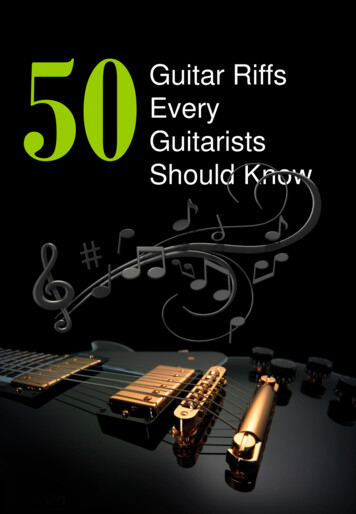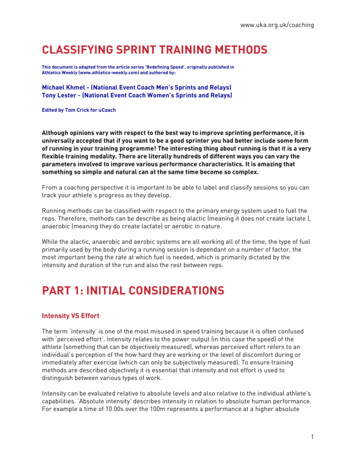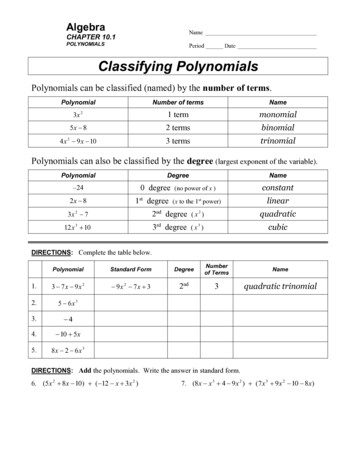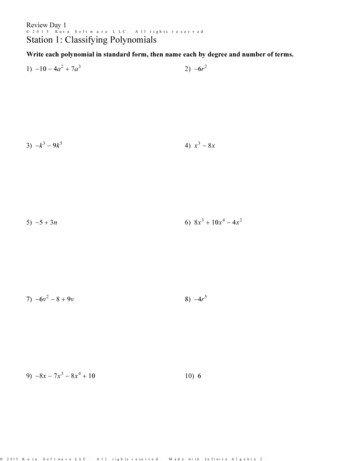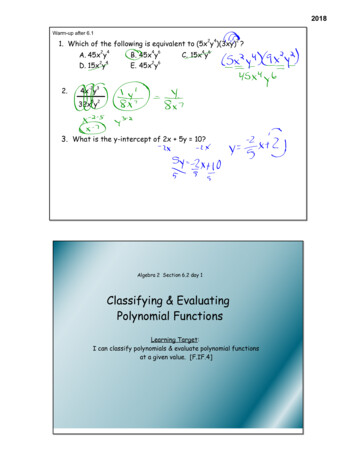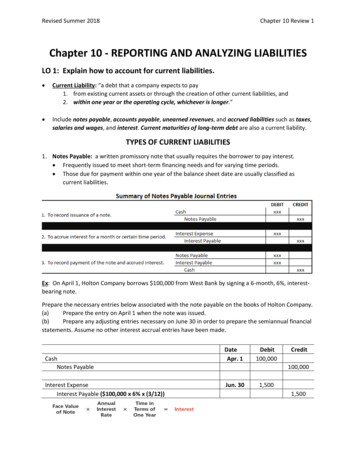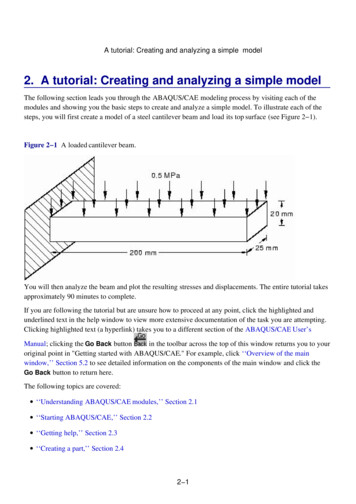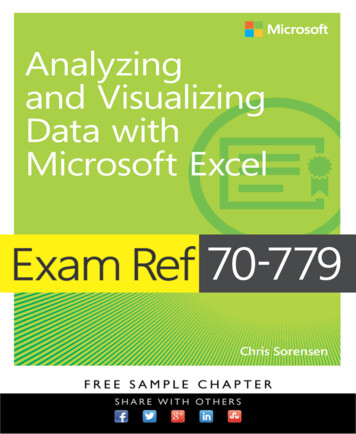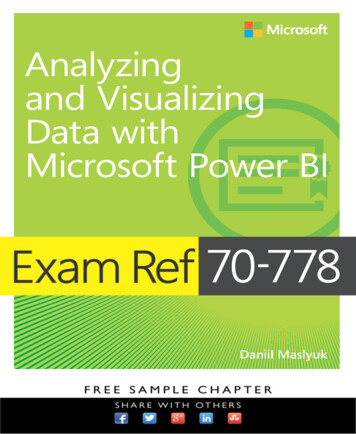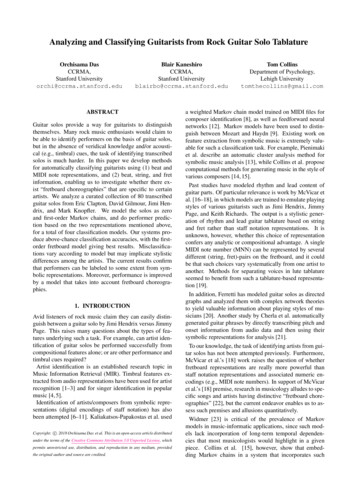
Transcription
Analyzing and Classifying Guitarists from Rock Guitar Solo TablatureOrchisama DasCCRMA,Stanford Universityorchi@ccrma.stanford.eduBlair KaneshiroCCRMA,Stanford Universityblairbo@ccrma.stanford.eduABSTRACTGuitar solos provide a way for guitarists to distinguishthemselves. Many rock music enthusiasts would claim tobe able to identify performers on the basis of guitar solos,but in the absence of veridical knowledge and/or acoustical (e.g., timbral) cues, the task of identifying transcribedsolos is much harder. In this paper we develop methodsfor automatically classifying guitarists using (1) beat andMIDI note representations, and (2) beat, string, and fretinformation, enabling us to investigate whether there exist “fretboard choreographies” that are specific to certainartists. We analyze a curated collection of 80 transcribedguitar solos from Eric Clapton, David Gilmour, Jimi Hendrix, and Mark Knopfler. We model the solos as zeroand first-order Markov chains, and do performer prediction based on the two representations mentioned above,for a total of four classification models. Our systems produce above-chance classification accuracies, with the firstorder fretboard model giving best results. Misclassifications vary according to model but may implicate stylisticdifferences among the artists. The current results confirmthat performers can be labeled to some extent from symbolic representations. Moreover, performance is improvedby a model that takes into account fretboard choreographies.1. INTRODUCTIONAvid listeners of rock music claim they can easily distinguish between a guitar solo by Jimi Hendrix versus JimmyPage. This raises many questions about the types of features underlying such a task. For example, can artist identification of guitar solos be performed successfully fromcompositional features alone; or are other performance andtimbral cues required?Artist identification is an established research topic inMusic Information Retrieval (MIR). Timbral features extracted from audio representations have been used for artistrecognition [1–3] and for singer identification in popularmusic [4, 5].Identification of artists/composers from symbolic representations (digital encodings of staff notation) has alsobeen attempted [6–11]. Kaliakatsos-Papakostas et al. usedCopyright: c 2018 Orchisama Das et al. This is an open-access article distributedunder the terms of the Creative Commons Attribution 3.0 Unported License, whichpermits unrestricted use, distribution, and reproduction in any medium, providedthe original author and source are credited.Tom CollinsDepartment of Psychology,Lehigh Universitytomthecollins@gmail.coma weighted Markov chain model trained on MIDI files forcomposer identification [8], as well as feedforward neuralnetworks [12]. Markov models have been used to distinguish between Mozart and Haydn [9]. Existing work onfeature extraction from symbolic music is extremely valuable for such a classification task. For example, Pienimakiet al. describe an automatic cluster analysis method forsymbolic music analysis [13], while Collins et al. proposecomputational methods for generating music in the style ofvarious composers [14, 15].Past studies have modeled rhythm and lead content ofguitar parts. Of particular relevance is work by McVicar etal. [16–18], in which models are trained to emulate playingstyles of various guitarists such as Jimi Hendrix, JimmyPage, and Keith Richards. The output is a stylistic generation of rhythm and lead guitar tablature based on stringand fret rather than staff notation representations. It isunknown, however, whether this choice of representationconfers any analytic or compositional advantage. A singleMIDI note number (MNN) can be represented by severaldifferent (string, fret)-pairs on the fretboard, and it couldbe that such choices vary systematically from one artist toanother. Methods for separating voices in lute tablatureseemed to benefit from such a tablature-based representation [19].In addition, Ferretti has modeled guitar solos as directedgraphs and analyzed them with complex network theoriesto yield valuable information about playing styles of musicians [20]. Another study by Cherla et al. automaticallygenerated guitar phrases by directly transcribing pitch andonset information from audio data and then using theirsymbolic representations for analysis [21].To our knowledge, the task of identifying artists from guitar solos has not been attempted previously. Furthermore,McVicar et al.’s [18] work raises the question of whetherfretboard representations are really more powerful thanstaff notation representations and associated numeric encodings (e.g., MIDI note numbers). In support of McVicaret al.’s [18] premise, research in musicology alludes to specific songs and artists having distinctive “fretboard choreographies” [22], but the current endeavor enables us to assess such premises and allusions quantitatively.Widmer [23] is critical of the prevalence of Markovmodels in music-informatic applications, since such models lack incorporation of long-term temporal dependencies that most musicologists would highlight in a givenpiece. Collins et al. [15], however, show that embedding Markov chains in a system that incorporates such
long-term dependencies is sufficient for generating material that is in some circumstances indistinguishable fromhuman-composed excerpts. Whether the zero and firstorder Markov models used in the present study are sufficient to identify the provenance of guitar solos is debatable; however, we consider them a reasonable startingpoint for the task at hand.The rest of this paper is organized as follows. We describe the dataset and features, Markov models and maximum likelihood interpretations, and our classification procedure in Section 2. In Section 3 we visualize our dataand report classification results. We conclude in Section 4with discussion of results, insights into stylistic differencesamong the artists, potential issues, and avenues for futureresearch.2. METHOD2.1 DatasetWe collated our own dataset for the present study, since nopre-existing dataset was available. First, we downloadedguitar tabs in GuitarPro format from UltimateGuitar. 1 Thequality of tabs was assessed by us as well as the numberof stars they received from UltimateGuitar users. Any tabwith a rating below four stars was discarded. We then manually extracted the guitar solos from each song’s score andconverted them to MusicXML format with the free TuxGuitar software. 2 In total, our final dataset comprised 80solos—20 each from Eric Clapton, David Gilmour, JimiHendrix, and Mark Knopfler. While the size of this datasetis in no way exhaustive, the number of songs curated wasrestricted by the availability of accurate tabs.2.2 RepresentationsFor parsing MusicXML data and symbolic feature extraction, we used a publicly available JavaScript library. 3 Using methods in this library, we wrote a script that returnsontime (symbolic onset time), MIDI note number (MNN),morphetic pitch number (MPN), note duration, string number, and fret number for each note in the solo. To obtain thebeat of the measure on which each note begins, we took itsontime modulo the time signature of that particular solo.The tonic pitch of each song was identified from the keysignature using an algorithm in the JavaScript library thatfinds the tonic MIDI note closest to the mean of all pitchesin a song. We then subtracted this tonic MNN from eachraw MNN to give a “centralized MNN”, which accountedfor solos being in different keys. When calculating pitchclass, we took centralized MNN modulo 12 to limit valuesto the range [0, 11].For guitar players, fingering positions on the fretboardare crucial. To account for variability in key along the fretboard, solos were transposed to the nearest C major/A minor fretboard position on the same string, making surethere were no negative frets. If a fret number was greaterthan or equal to 24 (the usual number of frets on an electric guitar), it was wrapped back around to the start of thefretboard by a modulo 24 operation, resulting in the fretrange [0, 23]. The resulting dimensions of beat, MNN,pitch class, string and transposed fret were saved in JSONformat for each song in the dataset. Finally, we generatedtwo types of tuples on a per-note basis as our state spaces:the first state space comprises beat and centralized MNN,denoted (beat, MNN) hereafter; the second comprises beat,string, and transposed fret, denoted (beat, string, fret) hereafter. The quarter note is represented as a single beat. Forexample, an eighth note played on the fifth fret of the second string would be (0.5, 64) in the 2D (beat, MNN) representation and (0.5, 2, 5) in the 3D (beat, string, fret) representation.2.3 Markov ModelA Markov model is a stochastic model of processes inwhich the future state depends only on the previous nstates [24]. Musical notes can be modeled as random variables that vary over time, with their probability of occurrence depending on the previous n notes.In the present classification paradigm, let xi represent astate in a Markov chain at time instant i. In a first-orderMarkov model, there is a transition matrix P which givesthe probability of transition from xi to xi 1 for a set of allpossible states. If {x1 , x2 , .xN } is the set of all possiblestates, the transition matrix P has dimensions N N .Given a new sequence of states [x1 , x2 , .xT ], we canrepresent it as a path with a probability of occurrenceP (x1 , ., xT ). According to the product rule, this jointprobability distribution can be written as:P (x1 , ., xT ) P (xT xT 1 , ., x1 )P (x1 , ., xT 1 )(1)Since the conditional probability P (xT xT 1 , ., x1 ) in afirst-order Markov process reduces to P (xT xT 1 ), wecan write:P (x1 , x2 , .xT ) P (xT xT 1 )P (x1 , x2 , .xT 1 ) (2)Solving this recursively brings us to:P (x1 , x2 , .xT ) P (x1 ge.net/projects/tuxguitar/3 https://www.npmjs.com/package/maia-utilP (xi xi 1 )(3)i 2Taking the log of P (x1 , x2 , .xT ) gives us the log likelihood, L1 defined as:L1 log P (x1 ) TXlog P (xi xi 1 )(4)i 2Hence, the log likelihood can be calculated from the transition matrix P and initial distribution P (x1 ).For a zero order Markov model, the joint distribution issimply the product of the marginal distributions becausethe present state is independent of any of the past states:12TYP (x1 , x2 , .xT ) TYi 1P (xi )(5)
Therefore, the log likelihood is defined asL0 TXlog P (xi )(6)i 12.4 Classification ProcedureFor the present analysis, we performed classifications using a leave-one-out paradigm, i.e, we trained on all 79songs except the song being classified, and repeated thisfor all 80 songs in our dataset. 4 We used two different state spaces in our analysis: the 2D state space comprising beat and MNN, and the 3D state space comprising beat, string, and transposed fret. Each state in a statespace represents one note in a guitar solo. We then trainedzero-order and first-order Markov models on these data,and used a maximum likelihood approach to classify eachsong.For zero-order models, a probability list was constructedby obtaining the probability of occurrence of each uniquestate in the training data. This was done empirically bycounting the number of times a unique state occurred, anddividing this value by the total number of occurrences ofall states. A new set of states was obtained for an unseensong, and their probabilities were individually looked upin the probability list. If a state is previously unseen, wegive the probability an arbitrarily small value (0.00005) forthat state. The likelihood function L0 was calculated foreach artist, and the artist with maximum likelihood wasselected.For first-order models, the transition matrix P for a particular guitarist was found by training on all songs playedby him except the song being classified. Once we computed P for each guitarist, we calculated the probability offinding the sequence of states observed in the unseen testsong for each artist, and chose the artist whose transitionmatrix maximized the likelihood L1 , according toartist arg max L0,1 (a),a A(7)where A {Clapton, Gilmour, Hendrix, Knopfler}.Under a null hypothesis of chance-level classification,we assume a binomial distribution—having parameters p 1/nClasses ( 0.25), k nSuccesses, andn nTrials ( 80)—for calculation of p-values. Wecorrect for multiple comparisons using False DiscoveryRate [25].3. RESULTS3.1 Data Visualization3.1.1 HistogramsTo better understand the choice of notes used by each guitarist, we plotted pitch class and note duration histograms.As shown in Figure 1, the pitch class distributions shedlight on certain modes and scales that are used most frequently by the artists. For instance, the minor pentatonic4 The dataset consisting of JSON files, code for classification andanalysis are all included in tionscale (1, [3, 4, 5, [7) stands out prominently for all fourartists. It is also interesting to note that Eric Clapton usesthe 6th scale step more frequently than others. We performed chi-squared tests on all pitch class distributions toassess uniformity, with the null hypothesis being that thepitch class distributions are uniform and the alternate hypothesis being that they are not. The p-values were negligibly small, suggesting that none of the distributions are2uniform, but we report the χ statistic to see which distributions are relatively more uniform. Eric Clapton had the2largest χ value (5561.4), followed closely by Jimi Hendrix (4992.8), and then David Gilmour (3153.8) and MarkKnopfler (2149.7). A smaller chi-squared value indicatesless distance from the uniform distribution, providing evidence that Knopfler is more exploratory in his playing stylebecause he makes use of a wider variety of pitch classes.Note duration histogram
Guitar solos provide a way for guitarists to distinguish themselves. Many rock music enthusiasts would claim to be able to identify performers on the basis of guitar solos, but in the absence of veridical knowledge and/or acousti-cal (e.g., timbral) cues, the task of identifying transcribed solos is much harder. In this paper we develop methods
